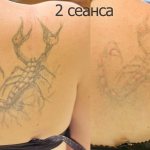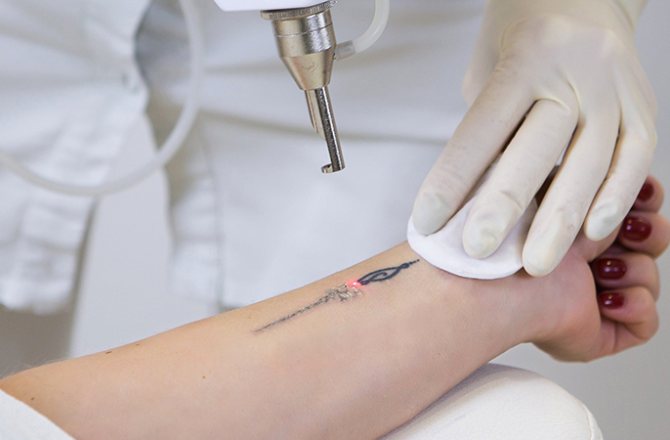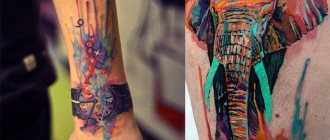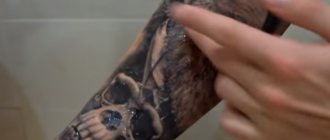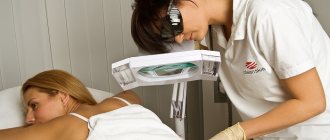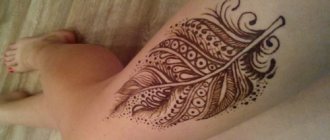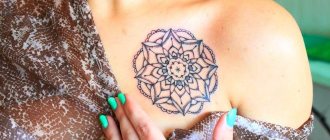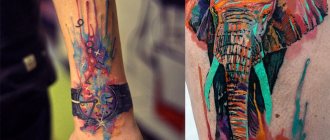- Artisanal tattoos require fewer treatments;
- Small drawings are reduced in a short time, provided that the drawing is not dense;
- Dark skin requires fine tuning of laser power, the number of procedures increases;
- Bright, dense tattoos take longer to reduce;
- Drawings located on the legs require more sessions for removal.
Total treatment time is about a year. This information can be taken as basic. How many sessions it takes to remove a tattoo with a laser, it is more precisely found out after consultation with a beautician.
Is it possible to remove a tattoo in one session?
As a rule no, but there are exceptions. For example, you have a one-time superficial application of permanent makeup in dark color or a small tattoo where there is little contouring and a lot of dark color pasted background. Provided the procedure is performed with a certified picosecond laser.
There is also a new method of removal - R-20, which reduces the number of sessions by 4 times. According to reviews, most patients refuse laser removal of tattoos because of the duration of treatment, which can stretch for up to 2 years.
With the new method, it is possible to remove a tattoo in 1 session if the design is small.
The procedure creates gas bubbles that dissolve within 20 minutes and allow the laser to treat deeper layers. The price of one session depends on the region where you live.
Which tattoo is easier to remove: a fresh or an old one.
Decorations older than 10 years are removed in half the time as fresh designs. Reasons why older tattoos are easier to get rid of:
- The sun works like a laser over a long period of time, gradually destroying the paint particles in the upper layers of the skin;
- The immune system considers the tattoo an alien inclusion and tries for years to destroy the paint.
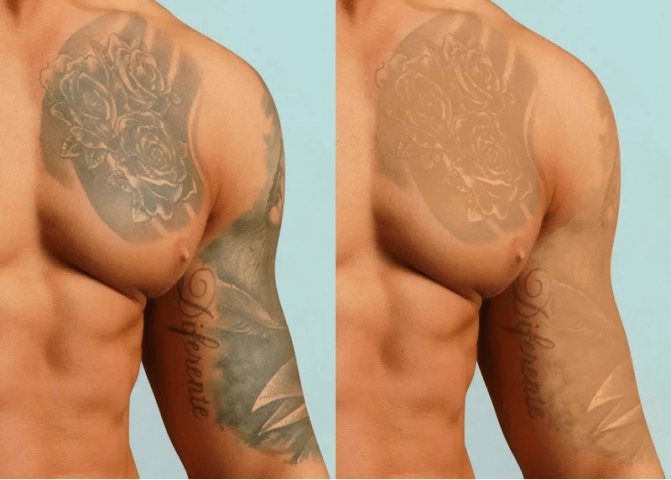
People with old tattoos will need no more than 6 sessions to completely remove the design. The effectiveness of the procedures is influenced by the same factors as for new tattoos - the pigments used, the location on the body, and the saturation of the ink.
Means and methods of tattoo removal
The best way to get rid of a tattoo is to go to a tattoo parlor with this problem.
At the moment there are many ways, each of which has advantages:
- Camouflage. The tattoo is overlaid with a new design. This can be either a new dark or colored tattoo, or an inconspicuous skin-colored tattoo.
- Cryosurgery. During the procedure, the skin is frozen and excised, removing the top layer of skin. Sometimes unpleasant scars remain after the session.
- Electrocoagulation. A painful and time-consuming procedure. High-frequency currents penetrate the skin, removing the dye from it.
- Laser removal. Expensive and painful, but effective.

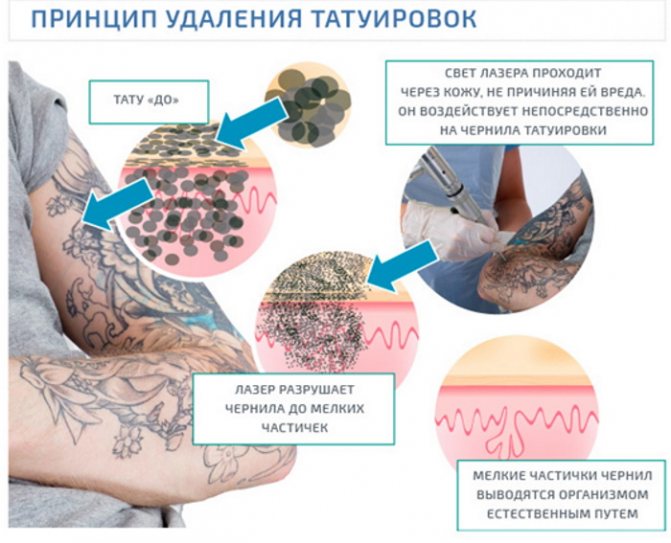
- Home abrasives and other techniques. They are discussed in more detail below in this article.
Almost any method of getting rid of a tattoo leaves a scar in its place. It is worth preparing mentally for this and choose the most gentle and effective method.
Special creams
A variety of creams and ointments can be effective only against recently done tattoos. Their cost is much lower than the procedure in the salon. But you do not have to wait for a serious result.
Withdrawal at home of an old tattoo or a tattoo made unprofessionally, exactly will not work. In addition, when removing a fresh, not yet fully healed tattoo, there is the possibility of infection.
Salt Scrub
To remove a tattoo at home most often try to use a salt scrub. Common salt is used for this purpose. Scrub tries to correct not only tattoos, but also stretch marks. He well exfoliates the upper layer of the skin. However, for a tattoo, this is not enough.
For the procedure you will need:
- a small cup;
- water;
- sea salt or table salt (it is better to take coarse);
- hydrogen peroxide;
- sterile bandage or gauze.
Preparation of the scrub is not complicated. Take 2 tablespoons of water for 2 tablespoons of salt, wait until the mass becomes homogeneous and stir the mixture.
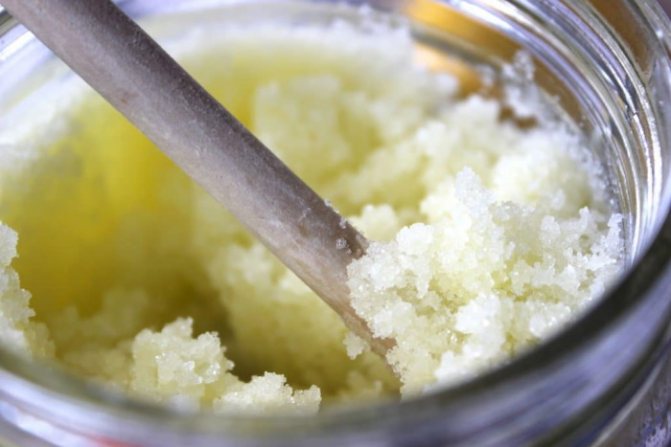

Use a scrub will have to at least 3 months, and do it regularly. In place of application the skin is likely to roughen and darken.
Application of salt scrub:
- The place of application should be cleaned, remove hair from it.
- Soap the skin area with laundry soap. Wipe it with a tissue paper.
- Take coarse salt and soak it in water, choosing a sterile dish.
- Apply the salt lump to a sponge. Massage the prepared skin area for about 30 minutes.
After the procedure, rinse off the salt with clean water. Place a bandage on the treated area.
Iodine
Iodine can also help to get rid of tattoos. But the method is dangerous.
Procedure when using iodine:
- Wash the tattoo site with soap and water.
- Dip a cotton swab in a 5% solution of iodine.
- Treat the surface of the skin with the tattoo. Iodine must not come into contact with clean skin.
Carry out this manipulation 3 times a day for several months. The treated surface should not be immediately covered with a bandage. This could cause a severe burn. After a short period of time, the top layer of skin will begin to die off and peel. The skin should not be torn off. Once all the layers containing pigment have peeled off, the tattoo will disappear.
Iodine most often causes itching. It can be relieved with an ointment with antibacterial components. The area where iodine is applied should be protected from any influences for about 3 hours after each treatment.
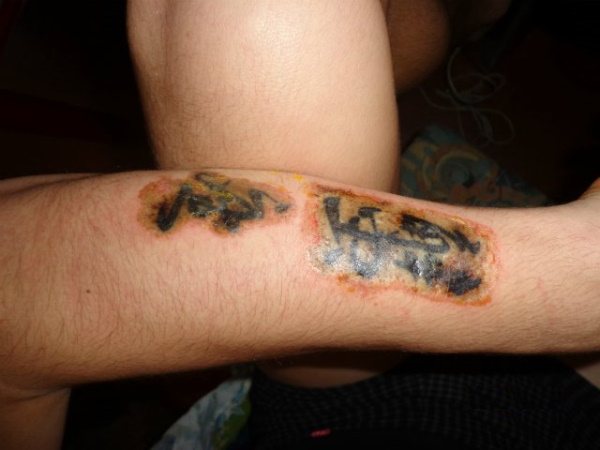

Before going to bed, the skin in the treatment area can be lubricated with moisturizing cream. The tattooed area will gradually stop peeling. An abrasion-like wound will appear on the area.
As soon as this happens, the iodine treatment should be discontinued. The wound is sprinkled with streptocide, which will help disinfect the skin area and dry it out. Until a new layer of epidermis forms on the surface of the skin, you cannot repeat the treatment. It will take about two weeks.
The number of stages of treatment of the area with a tattoo depends on the depth of penetration of the paint. Some people do not endure the entire procedure to the end. It is not only long, but also extremely unpleasant. But as a result, if the technology is followed, no scar will remain.
Sea salt or table salt
Soaking it in salt water is one way to remove a tattoo. Many people say that the procedure will help completely painless and completely remove the ink from the thickness of the skin. The maximum effect that can be achieved is a paling of the tattoo. A fresh picture runs the risk of blurring and acquiring an absurd look. But to get a skin irritation can be easy.
Soak the tattoo in a strong salt solution. It is necessary to keep a site of skin in it about half an hour daily. Most likely this procedure will lead to the ink spill and its small discoloration. The tattoo, most likely, will not disappear entirely. The result will be a fuzzy spot of paint of incomprehensible outlines.
Celandine .
Tincture of celandine is used in the fight against warts for the reason that it is able to burn off the top layer of skin. It is this property that will come in handy for tattoo removal.


To reduce the tattoo at home celandine can be the following sequence of actions:
- Soak a cotton pad in the tincture.
- Dab the product on the skin with the pattern. It is better not to touch the healthy skin.
- Treat the surface with hydrogen peroxide, which will help to avoid infection, as burns can occur at the place of treatment.
- Bandage the place of application of celandine tincture with a sterile dressing.
It will take about 2 months of daily treatments to remove the tattoo. But it is likely to leave a very noticeable scar in its place. Tincture of celandine can be made yourself at home. Put the green parts of the plant in a bottle and pour it with medical alcohol. The composition is insisted for 2 weeks in the refrigerator, shaking periodically.
Vinegar .
A similar effect has acetic acid. The method is effective, but painful and dangerous. In addition, the skin is sure to leave a scar. In the process of applying vinegar to reduce tattoos, you may get a painful shock and a severe burn. Therefore it is better to address in salon in which professionals work. But if the decision is made, it is better to wear gloves. You can apply vinegar in 2 ways.
Option one:
- Immerse a cotton swab in vinegar.
- Blot the area of the skin with the pattern.
- Wait for 5 minutes.
- Rinse off the vinegar with cool water, preferably boiled water.
- Treat the place where vinegar was applied with hydrogen peroxide. This will help disinfect the skin area.
- Place a sterile dressing on the treated area of the skin.
Repeat the procedure every day for a week, then take a break for 14 days. The course in this order should be repeated for 3 months.
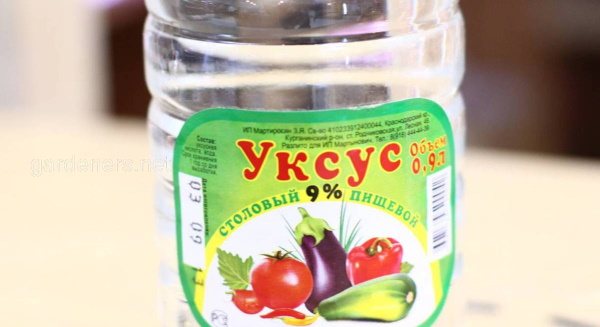

The second option is not less painful. It is better to carry out it with the help of an assistant.
Sequence of actions:
- Fill the machine for stuffing tattoos instead of paint with vinegar.
- With her help outline the contour of the existing tattoo.
- Repeat the procedure every day until the tattoo disappears.
It is necessary to disinfect the place where the procedure is carried out. And after its termination to put a sterile bandage. The same method is used when using hydrogen peroxide. It is filled into the machine for tattooing. Then the peroxide is injected under the skin in the location of the ink. It is important not to touch the skin free of ink to avoid its irritation.
After using the machine, aloe or specialized disinfectant and healing ointments are applied to the site. Peroxide makes the paint lighter. It is not as harmful as the other listed preparations, but it can also have a negative effect on the body. And its use can end in blood poisoning.
Manganitsa .
It is possible to remove a tattoo at home with the help of manganese dye, but this method is even more dangerous than the previous ones. It should be used very carefully, as you can get burns, infections and other unpleasant consequences.
You will need a powder of manganese. You can buy it in a pharmacy. The powder is applied only to the drawing, and then moisten it. Not to wash off with water, but exactly to moisten the manganese, it is convenient to use a sprayer.
Then the tattoo is covered with a package for several hours. Manganese burns the skin anywhere the powder is applied. Therefore, not only the tattoo but also the healthy skin in the vicinity will suffer.
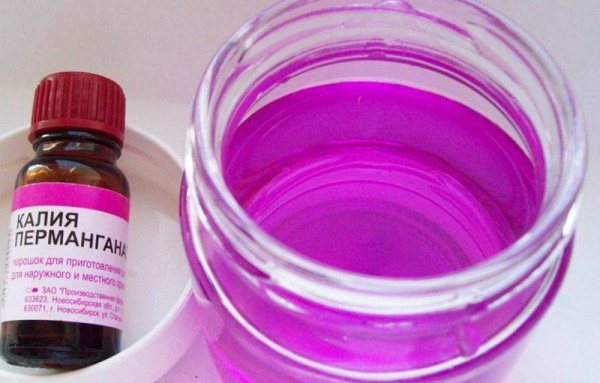

After removing the package, the owner of the tattoo will see a wound on the skin. It should be rinsed with water and anointed with an ointment containing antiseptic. A cream with a healing effect will work well. For complete removal of the tattoo it will be necessary to carry out the procedure regularly until all the skin with pigment will not be destroyed.
The use of manganese may leave scars and other changes on the skin.
Milk
A terrifying method that is extremely dangerous. In spite of this, it is used.
The procedure will require:
- fermented milk;
- syringe;
- streptocide;
- a sterile dressing.
Milk is drawn into the syringe and brought under the skin, where it begins to rot. This can easily cause sepsis, which is very likely to cause death. To at least keep yourself safe, the tattoo is sprinkled with streptocide.
The processes of decay "remove" the paint. After the end of the procedures, scars remain on the skin. A blood infection is treated in hospital conditions and, despite this, the percentage of deaths is quite high. Therefore, the milk method should not be recommended to anyone.
Ammonia
This substance is able to burn the upper layer of the skin. This property is the reason for its use for the removal of tattoos. Prepare the solution for treatment in a special way. Ammonia alcohol is diluted with water 1 to 1. But instead of water can be used calendula tincture. This will help to disinfect the treatment site, because there will be a burn.
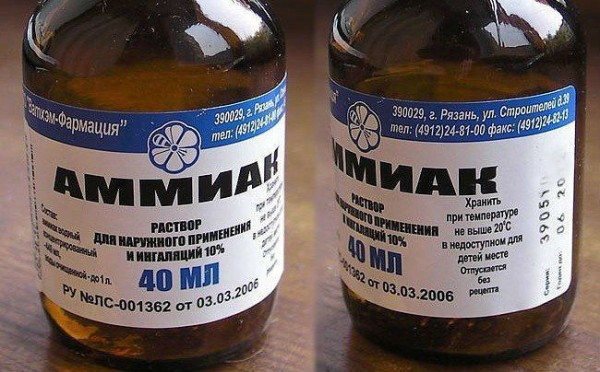

Preparation of calendula tincture:
- 3 tbsp. of marigold pour 250 ml of boiling water.
- Boil the solution over low heat for 30 minutes.
- Strain the decoction through gauze and cool it.
Ammonia alcohol is mixed with the resulting decoction and applied with a cotton swab to the tattoo. Then the treatment site is covered for a few hours with plastic wrap. The procedure is repeated 2 times a day until the pattern disappears. If a severe burn is formed at the place of application, the treatment is stopped until the skin recovers.
What should be the intervals between treatments
The time frame between treatments is set to allow the skin to recover from exposure. The usual time needed for healing is 4-6 weeks. If recovery is slower for various reasons, your doctor will advise you to come back in one more week.
If the time between laser tattoo removal procedures is too short, complications such as infections, burns, scars and pigmentation disorders of the epidermis are possible.
Between sessions it is necessary to take good care of your skin - keep it away from the sun, do not use aggressive agents, use Bepanten or similar products.
Contraindications to laser tattoo removal
Laser removal is one of the safest procedures. But this treatment has several contraindications:
- In pregnancy and breastfeeding sessions can be harmful to the mother's body. But even in the early term, tattoo removal will not affect the fetus;
- It is not allowed to be exposed to sunlight on the tattoo to be removed 2 weeks before going to the doctor. Remember that ultraviolet light also affects the skin in winter;
- Before starting the course, you must stop taking antibiotics and other medications that affect the immune system. It is necessary to treat infections for at least one month before removing tattoos;
- Laser tattoo removal is not recommended for people with serious illnesses - HIV, hepatitis C and B, diabetes, eczema and epilepsy;
- If the integrity of the skin in the projection of the laser is compromised;
- Cancer or chronic diseases in the acute stage;
- You cannot remove a tattoo or permanent makeup done less than 6 weeks ago.


Are some tattoos really impossible to remove?
Some tattoos are difficult to remove that were made by handicrafts. For example prison or military tattoos can be difficult to remove. The same refers to homemade machines or even more exotic ways.
Even after processing such partaks leave a distinctive trace of the drawing on the skin. However, after repeated laser therapy, these options can also be negated. Patience, compliance with all requirements and plenty of time will be required of the wearer.
It is not recommended to reduce tattoos in intimate areas:
- lip skin
- eyelids
- On the mucous membranes.
Also tattoos done all over the body or in large areas are dangerous to reduce because of the heavy load on the skin.
We advise you to read: the care for tattoos
